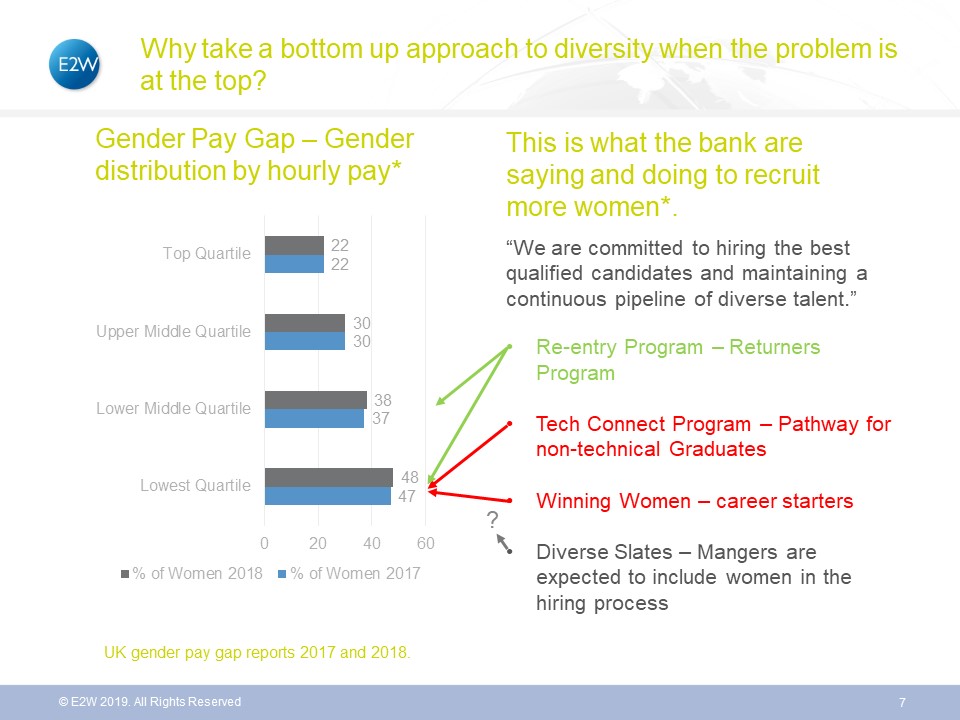
Why are we taking a bottom up approach to diversity when the problem is at the top?
Mark.Freed / 13 Nov 2019
This week I have met a number of people, separately, from a major investment bank here in London. I shall not name the bank as most readers will recognise the problem at their own banks.
The bank’s gender pay gap report statistics are not dissimilar to their peers (figures rounded):
- 50% of their lower quartile earners are women
- 40% of their lower middle quartile earners are women
- 30% of their upper middle quartile earners are women
- 20% of their top quartile earners are women
I’m sure all the good things they are doing, that are highlighted in their report to close the gap are well considered, thought out and will play a part in moving the dial. For obvious reasons, it’s the initiatives they are taking in recruitment that catch my eye. I am particularly interested in the steps to recruit more senior women into upper middle and top quartile roles - after all, that is where the gap is and the needs are. Recruiting more women into these quartiles, when seeking external candidates to fill open vacancies, will deliver an immediate and lasting positive effect.
I have highlighted below what this particular Bank mentioned in their gender pay gap with regards to recruiting more females.
- School Outreach
- University Outreach
- Diverse Candidate Shortlists
- Supporter of Flexible Working
- Return To Work programmes
This is not surprisingly very similar to all their peers, although they did not mention, as others have, gender natural job specs/adverts.

My observations:
School outreach is great, encouraging students to pursue a career within financial services is commendable. However, how many of these 17 year olds will reach the upper, middle quartile paying roles in the next 10 years?
With regards to graduate recruitment, this can also be very positive when encouraging a new generation into financial services. However, given the hundreds of applicants for every graduate place - it’s not hard to make graduate recruitment diverse! This firm is already gender equal at lower level. Therefore, recruiting a gender balanced graduate intake, which is their stated desired outcome, is only maintaining the status quo.
Thinking about the supporter of flexible working does not seem to be a recruitment strategy, but more of a broad and welcome policy to attract and retain great people. Perhaps it was slipped in to fill the page!
Return to work programmes have largely been aimed at VP level and below. Therefore, in the short term making the lower middle quartile diversity figures better. However, these statistics are not bad today, but the focus needs to be on the senior end.
For those wondering, I did enquire about how many women from the Returnship had secured permanent roles at the end. I am yet to receive an answer, which makes me think the answer will be very low. However, it does make their report look good.
Whilst gender natural job specs are great, a women with a 30 year career in the industry are not as likely as a graduate to be put off by the language in a job specification, that reflect her experiences in her daily working life.
Looking at their stance on diverse candidate shortlists, my conversations with a hiring manager, head of recruitment and in-house recruiter that I met this week summed up the effectiveness of these strategies:
Hiring manager:
“Ah yes the diversity police. We know ways around them.”
Recruiter:
“I’m targeted on time and cost of hire. Diversity is a nice to have. If I can only find male candidates it means there are no female candidates…”
Head of Recruitment:
“We don’t actually see more than half of senior hires until a hiring manager comes to us with a preferred candidate, for us to onboard. The roles that we do handle, group wide cost and time to hire strategies prevent us using external agencies, even if that agency could provide female candidates and we can’t find any!”
My research showed that only about 20% of senior hires into the firm were women. This combined with two years’ worth of gender pay gap data, demonstrates that these strategies are not increasing the proportion of women in top quartile earners.
Ensuring that great diverse candidates, with a realistic chance of securing the role, are found for open senior positions is worth the investment and time. It results in more diverse hires. That positively move the statistics, it starts to deliver the benefits of diversity today, improves the culture and provides role models for those graduates and sets an example for other senior managers - confirming the leaderships commitment.
At this point, many will be claiming a lack of female talent at these senior levels.
This is something we at E2W find hard to believe. We have an abundance of great female talent, looking for their next career move in the industry. In fact, our challenge is the opposite - we have more great female candidates than roles to work on!
So we have a challenge for the industry...
Let us prove that there are plenty. Release three senior level roles to us at the point they are approved and we will provide you with nine outstanding female candidates. Candidates who are likely to turn out to be the best person for the job, the team and firm.
Take the E2W “Three Role Challenge” and let us prove that there is an abundance of female talent in the industry.
I look forward to hearing from you and hope that you will accept the challenge!
For more information please contact mark.freed@e2w.co or call 01732 897722
Back to blog



 Women in Financial Services
Women in Financial Services